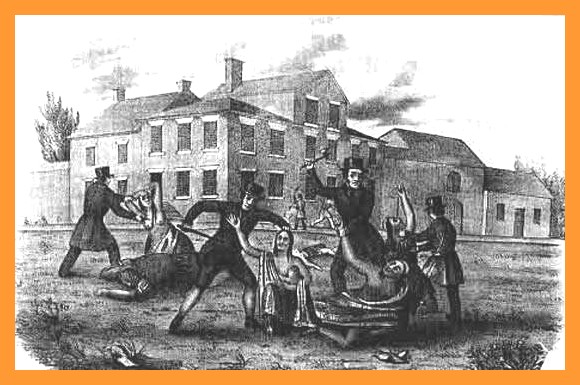The Conestoga Indians were also known as the Susquehannock Indians. The Paxton Boys were a group of frontier ruffians of Scotch-Irish descent who lived in the Central Susquehanna Valley in Pennsylvania. They formed a vigilante group to retaliate against the local Indians for what they believed to be assistance and intelligence given by those Indians in the French and Indian War. It is widely accepted that the Paxton Boys were responsible for the massacre of the remaining members of the Conestoga – men, women and children, the last of whom were given protection by the authorities at Lancaster, Pennsylvania. The collective events, including those which led to the final murders at Lancaster became known as the Conestoga Massacre(s).
Another account of the massacre, published about 1820, is presented here:
Extract from Heckwelder’s Narrative
We find the following particulars of this sad massacre in Heckwelder’s Narrative [published about 1820], and as the accounts are somewhat contradictory, as regards the persons who were the perpetrators, we can have every reliance on the description here given.
A party of fifty-seven white people, bearing the name of Christians,* set out from Paxton, to attack and destroy a small settlement of peaceable and inoffensive Indians in Conestoga, near Lancaster, where they had resided for more than a century, and whose ancestors had been among those who had welcomed William Penn on his first arrival in this country, presenting him at the time with venison, &c. Those not happening to be all at home at the time, some being scattered among their white neighbors, they murdered those they met with, to the number of fourteen persons, men, women and children; the rest, learning what had befallen their friends and relations, fled, by the advice of their friendly neighbors, to Lancaster, for protection, and were there placed in the jail for their safety — where, however, this mob party, now under the name of Paxton boys, arrived; and having broken open the door, entered, and most cruelly murdered every one of them, although they begged on their knees that their lives might be spared, they being real friends of the English. The mob was so intoxicated with their success, that after they had finished their inhuman butchery on those truly innocent Indians, they they threw their mangled bodies into the street,** and with a dreadful shout, as if they had gained a great victory, threatened that the Indians on Province Island, (the Christian Indians, together with Papunhak’s peaceable party,) should soon share the same fate.
Note. — That there appeared to be something unaccountable in this affair, will be seen from the following extract of a letter, addressed to the writer of this narrative by a respectable and intelligent gentleman of Philadelphia. “There are,” says he, few, is any, murderers to be compared with the cruel murder committed on the Conestoga Indians in the jail of Lancaster, in 1863, by the Paxton boys, (as they were then called). From fifteen to twenty Indians, as report stated,were placed there for protection. A regiment of Highlanders were at that time quartered at the barracks in the town, and yet these murderers were permitted to break open the doors of the city jail and commit the horrid deed. The first notice I had of this affair was, that, while at my father’s store, near the court-house, I saw a number of people running street towards the jail, which enticed me and other lads to follow the, At about sixty or eighty yards from the jail, we met from twenty-five to thirty men, well mounted on horses, and with rifles, tomahawks, and scalping-knives, equipped for murder. I ran into the prison yard, and there, O what a horrid sight presented itself to ny view! — Near the back door of the prison lay an old Indian and his squaw (wife), particularly well known and esteemed by the people of the town on account of his placid and friendly conduct. His name was Will Sock; across him and his squaw lay two children, of about the age of three three years, whose heads were split with the tomahawk, and their scalps taken off. Towards the middle of the jail yard, along the west side of the wall, lay a stout Indian, whom I particularly noticed to have been shot in the breast; his legs were chopped with the tomahawk, his hands cut off, and finally a rifle ball discharged in his mouth, so that his head was blown to atoms, and the brains were splashed against and yet hanging to the wall, for three or four feet around. The man’s hands and feet had also been chopped off with a tomahawk. In this manner lay the whole of them, men women and children, spread about the prison yard; shot — scalped — hacked — and cut to pieces.”
The governor issued a proclamation against these outrages, — forbidding, under the severest of penalties, any one to molest the Indians on Providence Island,*** and offering a reward of two hundred pounds to any one who should bring the two ringleaders of the above party to justice; but it soon became evident that their numbers were daily increasing, and that even in Philadelphia many were in secret connection with the ringleaders, who paid so little regard to government orders at that time, that they not only publicly walked the streets, but even presented themselves in front of the governor’s house, deridingly bidding him defiance.
____________________________
*In an account given by Arthur B. Bradford, a company of Presbyterians, from Paxtang Township, are blamed for this inhuman slaughter of the poor Indians. See Hazard’s Reg. Penn., Vol. 9, page 114.
**So the public papers stated, but ought to be Prison Yard.
***Near the city of Philadelphia.
